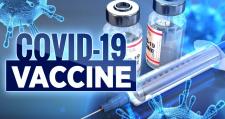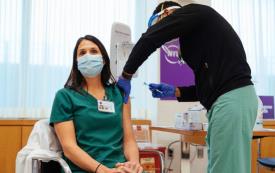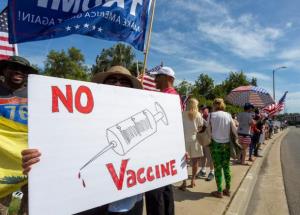 In order to resurrect our economy, it will be necessary to reduce the impact of COVID-19. To effectively suppress the infection, including emerging variants it will be critical to achieve a level of immunity approaching 75 percent of our entire adult population. Phase-3 trials in the U.S. and in other nations have demonstrated that the two mRNA vaccines n
In order to resurrect our economy, it will be necessary to reduce the impact of COVID-19. To effectively suppress the infection, including emerging variants it will be critical to achieve a level of immunity approaching 75 percent of our entire adult population. Phase-3 trials in the U.S. and in other nations have demonstrated that the two mRNA vaccines n ow deployed in the U.S. suppress clinical signs and almost eliminate hospitalizations. It is less clear whether immunized individuals are capable of transmitting the virus. Preliminary data from Israel where 80 percent of those over the age of 65 have been vaccinated and 40 percent of the entire population received at least one dose of vaccine, indicate a lower incidence rate in the non-vaccinated cohort. This suggests that increasing the proportion of immune individuals in the population through vaccination is actually reducing transmission rates as predicted by established epidemiologic theory.
ow deployed in the U.S. suppress clinical signs and almost eliminate hospitalizations. It is less clear whether immunized individuals are capable of transmitting the virus. Preliminary data from Israel where 80 percent of those over the age of 65 have been vaccinated and 40 percent of the entire population received at least one dose of vaccine, indicate a lower incidence rate in the non-vaccinated cohort. This suggests that increasing the proportion of immune individuals in the population through vaccination is actually reducing transmission rates as predicted by established epidemiologic theory.
Despite approval of both the Pfizer and Moderna vaccines during November and December 2020 respectively, both supply of the products and more important their administration, even to priority groups was initially beset with logistic restraints due to an obvious lack of planning and direction by federal authorities. As of February 12th, 3.6 percent of the U.S. population has received two doses of either of the vaccines and 11 percent have received the first dose. Effective February 15th, 70 million doses have been delivered and 52 million administered. It is evident that many of the logistic restraints to administration of vaccines are being resolved and the rate of vaccination attained 2.2 million on each of February 13th and 14th.
Dr. Scott Gottlieb, previously Commissioner of the Food and Drug Administration noted that the availability of vaccines will soon exceed the potential rate of administration even without the introduction of a third or fourth vaccine which in all probability will occur in March. Dr. Gottlieb correctly points out that "vaccine hesitantly" will soon be a restraint to attaining a level of immunity that is necessary to suppress the incidence rate in the U.S. The February 13th edition of The Economist considers the origin of vaccine hesitancy with specific reference to both industrialized and developing nations. Reluctance to receive a vaccine is based on a number of fears. These include concern over safety, evident from the Phase-3 trials; denial concerning the pathogenicity of COVID-19, with close to 500,000 fatalities denoting the severity of the infection; and group-sentiment fostered by mischievous, misleading and mendacious postings on social media.
 Some of the nonsense currently circulating include claims that the vaccine will allow mind control by sinister forces, that the vaccine will affect fertility, that vaccines are derived using fetal material or potentially rejecting the halal status of vaccines. There has also been a concerted attempt to devalue the advice of public health officials, hinting at untrustworthiness and ulterior motives. According to The Economist, The Center for Countering Digital Hate has tracked 425 anti-vaccine accounts on four major social medial platforms with close to 60 million followers. It emerged that 80 percent of the organizations that promote an anti-vax message have a financial justification for their opposition, since they promote and sell nostrums and remedies with unfounded claims for efficacy. A published research study has documented 1,300 Facebook pages opposing vaccination intertwining pseudo-scientific messages with conspiracy theories. Facebook has indicated that it will henceforth remove posts opposing vaccination. In a recent move, Instagram banned Joseph F. Kennedy Jr., a notorious opponent of all vaccinations from the platform, although his Facebook account remains active.
Some of the nonsense currently circulating include claims that the vaccine will allow mind control by sinister forces, that the vaccine will affect fertility, that vaccines are derived using fetal material or potentially rejecting the halal status of vaccines. There has also been a concerted attempt to devalue the advice of public health officials, hinting at untrustworthiness and ulterior motives. According to The Economist, The Center for Countering Digital Hate has tracked 425 anti-vaccine accounts on four major social medial platforms with close to 60 million followers. It emerged that 80 percent of the organizations that promote an anti-vax message have a financial justification for their opposition, since they promote and sell nostrums and remedies with unfounded claims for efficacy. A published research study has documented 1,300 Facebook pages opposing vaccination intertwining pseudo-scientific messages with conspiracy theories. Facebook has indicated that it will henceforth remove posts opposing vaccination. In a recent move, Instagram banned Joseph F. Kennedy Jr., a notorious opponent of all vaccinations from the platform, although his Facebook account remains active.
Public health authorities are currently analyzing and characterizing demographic groups opposed to vaccination and are attempting to develop countermeasures by specifically addressing their concerns. A history of exploitation characterized by the infamous Tuskegee Experiment and chronically inferior medical services has created hesitation in the black community that has suffered disproportionately from COVID-19. It is hoped that reluctance to be vaccinated will be remedied by responsible civic associations and greater accessibility to health services. Vaccination is receiving the endorsement of major black political, entertainment, academic and sports figures who serve as positive role models.
Some resistance to vaccination is inexplicable. A December 2020 survey among healthcare providers in Pennsylvania demonstrated a 45 percent reluctance to be vaccinated. These individuals including RNs do not lack education relating to how the virus is spread and how protection can be effected. In early December their concerns were based on the rate at which the vaccine was developed and the perception that approval by the FDA was rushed for political purposes in late October. Progressively, the sample of 16,000 healthcare workers has moved from a 45 percent level who were either disinclined to be vaccinated or elected to wait, to more than 75 percent agreeing to be vaccinated. By early February only five percent were implacably opposed to vaccination. The undecided group of healthcare workers is clearly diminishing as more of our population is vaccinated without adverse effects. In contrast workers in red-meat packing plants where vaccine has been made available have enthusiastically accepted immunization with or without financial inducements.
Recognition of the extent of vaccine hesitancy should now guide public health officials in developing promotional campaigns to encourage acceptance. With the greater availability of vaccines and improved logistics, over 200 million eligible members of the U.S. population could be vaccinated by late spring. The hard task will be to reach and vaccinate those over 16 who are either outright vaccine deniers, comprise the wait-and-see members of our population or for various reasons are inaccessible to health services. It will require a concerted program of public service campaigns to encourage acceptance of COVID vaccination to protect both individuals and the community. Some large companies are providing financial and other incentives to workers to be vaccinated. Other concerns and industries are actively pressing for their workers to be protected with the cooperation of state governors and health departments. It will be necessary to make vaccination successively more convenient and accessible following immunization of the first 200 million.
It is possible that resuming activities such as travel, attendance at crowded events and even community gatherings that we took for granted in 2019, will in future be contingent on proof of vaccination. As we roll out vaccines and effectively immunize an increasing proportion of our population, we hope that those who hesitated will join the mass and receive protection. If we end up with a 10 to 12 percent hard-core cohort of vaccine deniers, they will benefit from herd immunity.
With the emergence of variants and waning of immunity, it is inevitable that COVID will persist in our society requiring annual or biannual booster vaccination, much as we have accepted annual influenza “shots”. This will be a small price to pay for restoring our way of life and protecting the most vulnerable in our society.